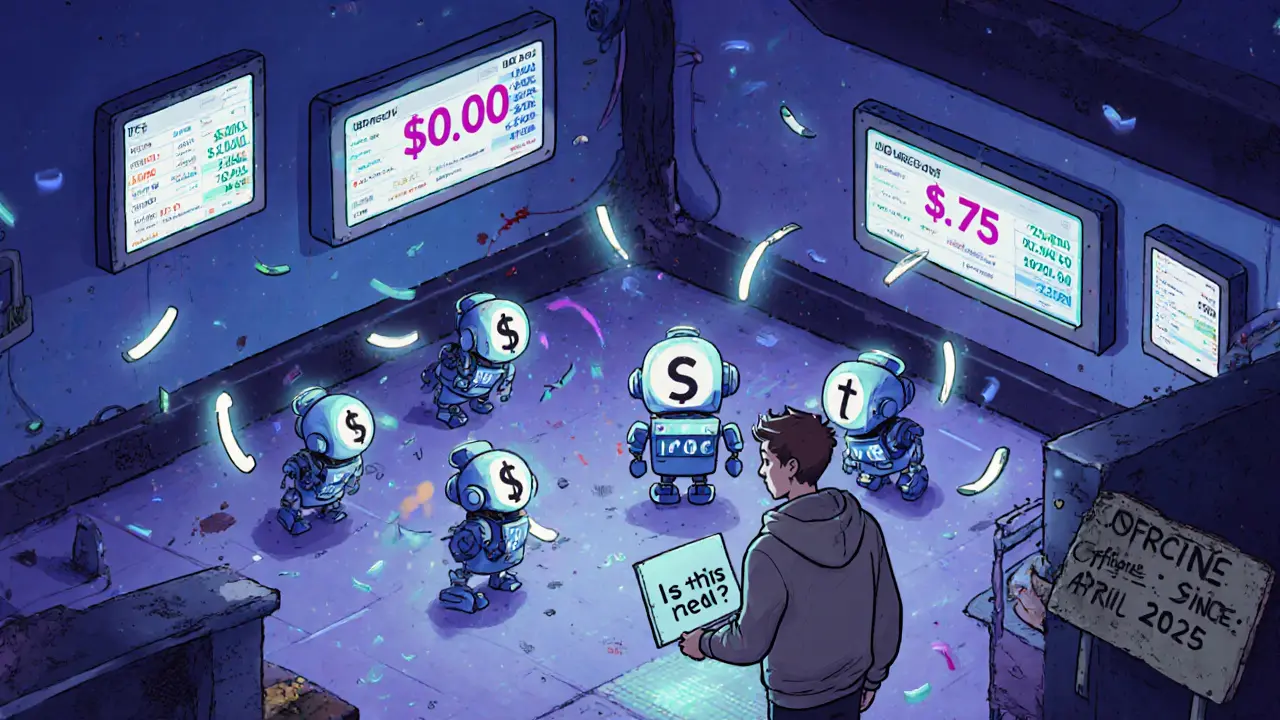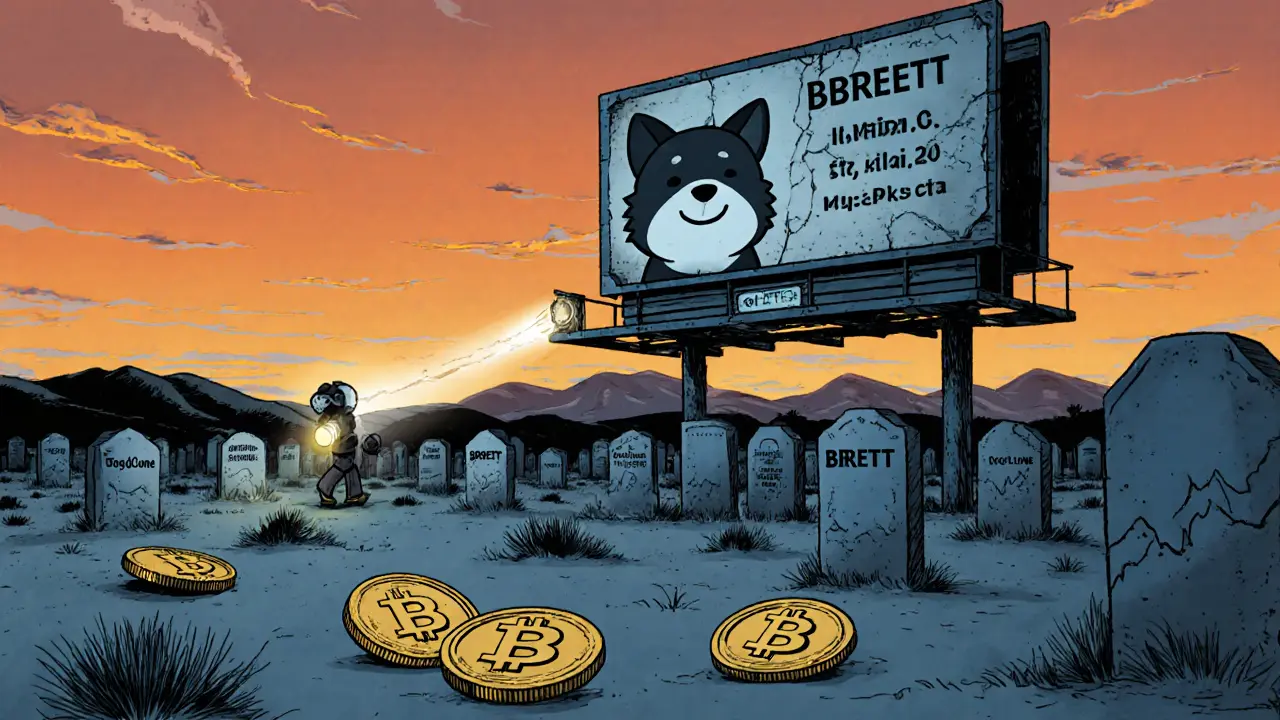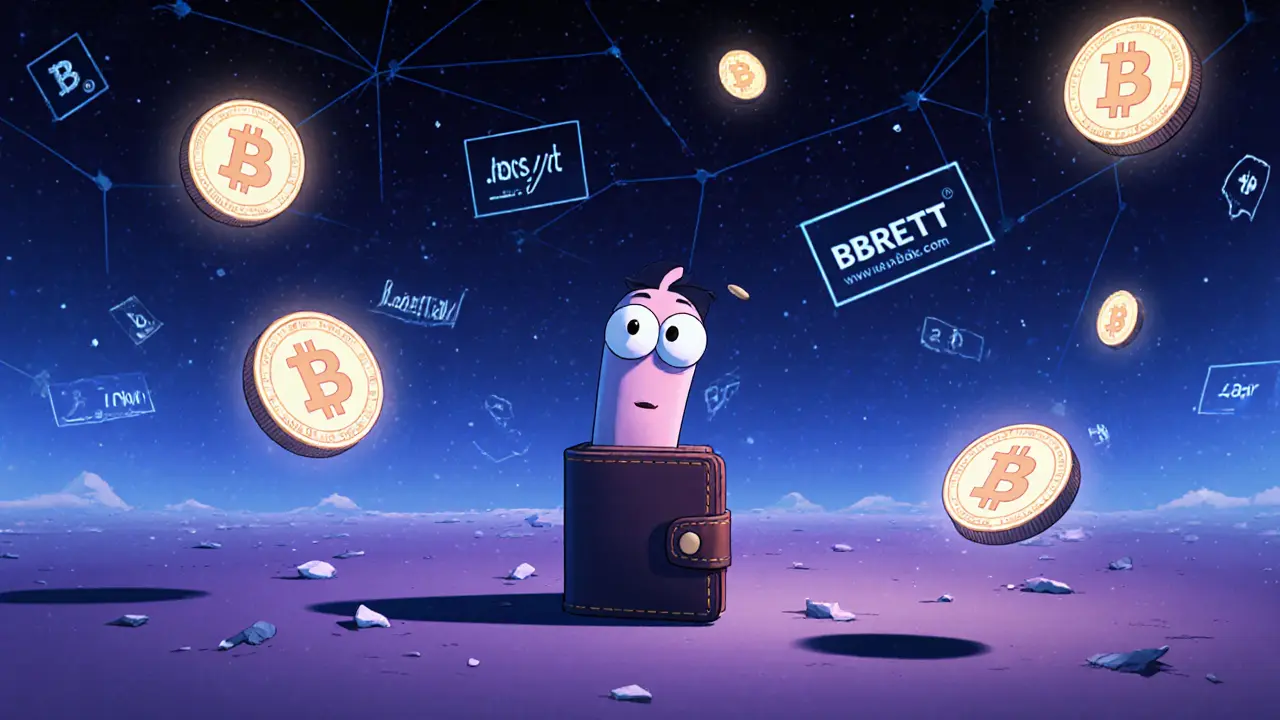Memecoin Viability Calculator
Project Assessment
There’s no official website. No active social media. No team behind it. And yet, over 121,000 wallets hold Baby Brett (BBRETT). If you’ve seen this token pop up on your crypto tracker and wondered what it is, you’re not alone. BBRETT is one of thousands of tiny memecoins floating around on the Base blockchain - but unlike Dogecoin or Shiba Inu, it doesn’t have a community, a roadmap, or even a working website. As of November 10, 2025, its market cap sits at just $105,860. That’s less than the cost of a used car. So why does it exist? And should you touch it?
What exactly is Baby Brett (BBRETT)?
Baby Brett (BBRETT) is a memecoin built on the Base blockchain, the layer-2 network launched by Coinbase in 2023. It’s not a project. It’s not a company. It’s not even a product. It’s a token with a name, a contract address, and a supply of exactly 100,000,000 coins. That’s it. No whitepaper. No team members named. No roadmap. No utility beyond being traded.
Some sources call it a "reward-driven" token that distributes $BRETT tokens to holders, but there’s no proof of how that works. No contract code explains it. No wallet has ever received a reward. The idea sounds like marketing fluff copied from other memecoins. The only real thing about BBRETT is its existence on-chain - and even that’s questionable in terms of legitimacy.
Where can you trade BBRETT?
You can only buy or sell BBRETT on Uniswap v2 running on the Base network. That means you need a Web3 wallet like MetaMask, set up for Base, and you need ETH to pay for gas fees. If you’re new to crypto, this alone is a major hurdle. You have to switch networks, find the right token address, set slippage to 10-15% (because the price jumps around wildly), and hope your transaction doesn’t fail.
There’s only one trading pair: BBRETT/ETH. And the volume? It’s a mess. CoinMarketCap says $0 in the last 24 hours. CoinGecko says $232. LiveCoinWatch says $1,130. That kind of inconsistency doesn’t happen by accident. It happens when bots are trading among themselves, or when one wallet is buying and selling to fake activity. This isn’t a market - it’s a stage with no audience.
What’s the price of BBRETT?
Here’s the reality: nobody knows the real price. Different exchanges show wildly different numbers:
- CoinGecko: $0.0003372
- CoinMarketCap: $0.000327
- LiveCoinWatch: $0.000754
- Symlix: $0.00 (with a -16.31% drop)
Why the difference? Because there’s no real buying or selling pressure. A single wallet buying 10 million BBRETT can spike the price. A few sellers can crash it. That’s why prices jump 60% in a week and then drop 16% in a day. This isn’t volatility - it’s manipulation. And it’s designed to lure in people who think they’re getting in early.

Who owns BBRETT?
Over 121,000 wallets hold BBRETT. Sounds impressive, right? But here’s the catch: most of those wallets hold less than 1,000 tokens. That’s less than $0.30 worth at the highest price. These aren’t investors. These are speculators who bought a few cents’ worth hoping to get lucky. Real holders - the kind who believe in a project - don’t hold tokens that cost less than a penny each. They hold assets with value, not digital lottery tickets.
The biggest holder? Unknown. No wallet has more than 1% of the supply. That’s unusual. In most memecoins, a few whales control the majority. Here, it’s spread out - which means no one has enough power to prop it up. And no one has enough incentive to dump it all at once. That’s why it just… sits there. Like a ghost town.
Why does BBRETT even exist?
It exists because the Base blockchain makes it stupidly easy to create a token. You don’t need approval. You don’t need money. You don’t even need to know how to code. All you need is a few minutes and a $5 gas fee. Thousands of tokens like this pop up every week. Most die within days. BBRETT has lasted longer than most - but only because it’s been copied and reposted on low-effort crypto Twitter threads and Telegram groups.
It’s not a coin. It’s a glitch in the system. A byproduct of a blockchain that rewards speed over substance. It’s the crypto equivalent of printing a $1 bill with a cartoon cat on it and selling it as a collectible. The only people making money are the ones who sold it before the price dropped.

Is BBRETT a scam?
It’s not a scam in the classic sense - there’s no evidence of a team stealing funds. But it’s a dead project. The official website has been offline since April 2025. No updates. No announcements. No community. That’s the biggest red flag. According to security firms like PeckShield, 72% of tokens with offline websites become completely worthless within six months. BBRETT is already past that point.
There’s no team to contact. No support. No roadmap. No future. If you buy BBRETT, you’re not investing. You’re gambling. And the house always wins.
Should you buy BBRETT?
No.
Not because it’s illegal. Not because it’s technically broken. But because it has zero chance of ever being worth anything more than a few cents. Even if the price doubles tomorrow, you’ll still be holding a token with no utility, no community, and no future. Selling it will be a nightmare. The liquidity is so low that even a small sale could drop the price by 50%. You’ll be stuck.
If you’re looking for a memecoin with real traction, look at tokens on Ethereum or Solana with active communities, verified teams, and real trading volume. BBRETT doesn’t even qualify as a footnote in the crypto world.
What’s the future of BBRETT?
There isn’t one.
Based on historical data from Chainalysis, 83% of memecoins with a market cap under $200,000 become completely illiquid within 18 months. BBRETT is at $105,860. It’s already in the danger zone. With no website, no updates, and no buyers, it’s only a matter of time before the last few holders give up and sell for pennies. Then it disappears - just another ghost token buried in the blockchain.
The only people who benefit from BBRETT are the ones who sold it early. Everyone else is just waiting for the price to go to zero - and hoping they’re not the last one holding.

Michael Faggard
November 12, 2025 AT 22:49BBRETT is a perfect example of why you don't chase zero-utility tokens. The Base chain has turned into a token factory - deploy, pump, dump, repeat. No team, no website, no roadmap - just a contract address and a dream. If you're holding this, you're not investing, you're just participating in a liquidity lottery. And the odds? Less than your phone's battery surviving a 24-hour TikTok binge.
Wayne Dave Arceo
November 14, 2025 AT 21:48Incorrect usage of the term 'memecoin' here. A memecoin implies cultural resonance, community-driven value, and at least nominal utility - Dogecoin had memes, Shiba Inu had a DAO, PEPE had a movement. BBRETT has none of these. It is not a memecoin. It is a tokenized glitch. The market cap is not $105,860 - it is $0.00 in real value. The numbers you see are artifacts of bot-driven wash trading. This is not crypto. This is financial theater.
Michael Heitzer
November 15, 2025 AT 09:55Let’s be real - BBRETT isn’t even a question of ‘should I buy it?’ It’s a question of ‘why does this still exist?’ The answer is simple: blockchain removes gatekeepers. That’s powerful. But it also means the internet can now mint infinite digital ghosts. BBRETT is one of them. It’s not evil. It’s not even malicious. It’s just… empty. Like a house with no furniture, no lights, no people. And yet, somehow, 121,000 wallets think they’re living there. That’s the real tragedy - not the price, but the belief.
ty ty
November 17, 2025 AT 04:49Wow. A coin worth less than a burrito. And people think this is investing? 🤡
BRYAN CHAGUA
November 18, 2025 AT 04:32While the data presented is thorough and accurate, it's important to remember that crypto markets are not always rational. Some individuals hold small positions not because they believe in the asset, but because they enjoy the ritual of monitoring it - the thrill of watching numbers change, even if they're meaningless. There’s a psychological component here that’s often overlooked. BBRETT may have no utility, but for some, it’s a digital hobby. Not wise, perhaps - but human.
Stephanie Platis
November 20, 2025 AT 01:22Let me be perfectly clear: You should NEVER, under any circumstances, touch this token. Zero. Nada. Zip. There is no excuse. No 'just a little' - no 'maybe it'll bounce back.' It's a digital ghost town with a ticker symbol. And if you're stupid enough to buy it, you deserve to lose everything. I'm not being harsh - I'm being honest. And I'm not sorry.
Joy Whitenburg
November 21, 2025 AT 02:39okay but like… why does this even exist?? 🤔 i swear i saw it pop up on my tracker and thought ‘is this a joke?’ and then i checked and… nope. it’s real. and people are holding it. like. actual humans. with real wallets. i’m both horrified and weirdly fascinated. also i think my cat has more utility than this token. 🐱
Kylie Stavinoha
November 21, 2025 AT 05:55There’s something haunting about BBRETT - not because it’s dangerous, but because it’s so utterly ordinary. It doesn’t scream scam. It doesn’t even try to be something. It just… is. Like a forgotten street sign in a town that no longer exists. And yet, people still look at it. Still check the price. Still wonder. Maybe it’s not about the coin at all. Maybe it’s about our need to find meaning in chaos. In a world where everything is monetized, even ghosts get a ticker.
Diana Dodu
November 22, 2025 AT 06:39USA is the only country that lets this garbage happen. In Europe, they’d shut this down in a week. No regulation? No oversight? That’s why crypto is a joke. You think this is freedom? It’s anarchy. And the people buying BBRETT? They’re not investors - they’re idiots. And we’re all paying for it with the reputation of real blockchain tech.
Raymond Day
November 23, 2025 AT 11:32THIS IS WHY WE CAN’T HAVE NICE THINGS. 🤬 Someone deployed this token on a Friday night after 3 Red Bulls and a TikTok binge. Now 121K people are holding it like it’s the next Bitcoin. I’ve seen the wallets - some of them have 0.0000000001 ETH in them. They’re not investing. They’re just hoping the blockchain will magically turn their 3 cents into a Lamborghini. Spoiler: it won’t. And when it crashes? They’ll blame the devs. But there are no devs. Just a 15-minute coding mistake and a whole lot of delusion.
Noriko Yashiro
November 25, 2025 AT 04:09Interesting perspective - but I think you’re underestimating the cultural phenomenon. BBRETT isn’t about value. It’s about participation. In a world where everything is algorithmically curated, this token is a glitch in the machine. A tiny rebellion against the idea that everything must have utility. People hold it because it’s absurd. And in absurdity, there’s beauty. Also, I bought 500,000 BBRETT last week. Just for fun. Not because I think it’s worth anything. But because I like watching the charts wiggle. 😊
Atheeth Akash
November 25, 2025 AT 23:32James Ragin
November 27, 2025 AT 13:37Did you know that the contract address for BBRETT was created by the same wallet that deployed 14 other tokens in the last 72 hours? All of them with similar names. All of them with zero documentation. All of them with fake volume. This isn’t random. This is coordinated. And the fact that CoinGecko and CoinMarketCap still list it? That’s not oversight - that’s complicity. The whole system is rigged. They want you to believe this is organic. It’s not. It’s a hive mind of bots and pump groups feeding off the gullible. And they’re laughing all the way to the next rug pull.
Michael Brooks
November 29, 2025 AT 00:29BBRETT is a perfect case study in how not to approach crypto. No team? Fine. No website? Okay. But zero liquidity? That’s the death knell. You can’t even sell without moving the price 40%. That’s not volatility - that’s a trap. If you’re holding this, you’re not a HODLer. You’re a hostage. And the only way out is to sell at a loss… which you’ll do eventually. So why not just save yourself the stress? Delete the wallet. Walk away. Your mental health is worth more than 37 cents.
David Billesbach
November 29, 2025 AT 08:20They say ‘don’t invest in what you don’t understand’ - but BBRETT is the only thing I understand. It’s pure capitalism. No fluff. No lies. Just a token with no purpose and a price that moves like a drunk kangaroo. I’ve watched it for 3 months. It doesn’t care if you’re rich or poor. It doesn’t care if you’re smart or dumb. It just exists. And that’s beautiful. In a world full of marketing, BBRETT is the only honest thing left. It says: ‘I’m nothing. Buy me if you want.’ And that’s more integrity than 90% of the ‘blue-chip’ projects out there.
Andy Purvis
November 30, 2025 AT 22:42I don’t know if I agree with everything here - but I appreciate the depth. Maybe BBRETT isn’t a coin. Maybe it’s a mirror. It reflects how far we’ve gone from real value. We used to build things. Now we just deploy contracts and hope someone else believes in them. I’m not buying BBRETT. But I’m not mad at the people who are. We’re all just trying to find meaning in a world that’s gone a little mad.
FRANCIS JOHNSON
December 2, 2025 AT 12:23BBRETT is the phoenix of crypto - not because it rises, but because it refuses to die. 🕊️ It’s the token that shouldn’t exist… and yet, here it is. Still trading. Still holding. Still whispering to 121,000 wallets like a lullaby for the hopeless. Maybe it’s not about the price. Maybe it’s about the hope. The quiet, desperate, beautiful hope that - just maybe - this time, the ghost will speak back.
Ruby Gilmartin
December 3, 2025 AT 17:21Let’s cut the sentimentality. This isn’t poetry. It’s not a metaphor. It’s not a ‘mirror.’ It’s a zero-value token with fabricated volume, zero liquidity, and no redeeming qualities. The fact that people are romanticizing it is the real scam. You’re not ‘philosophizing’ - you’re deluding yourself. And if you’re still holding BBRETT after reading this, you’re not a visionary. You’re a statistic. And I’m not being harsh. I’m being accurate.